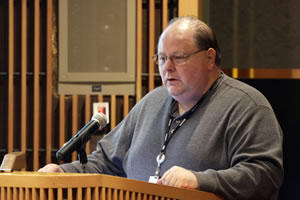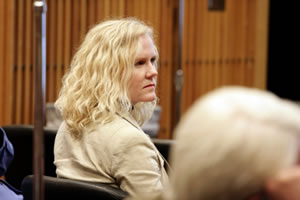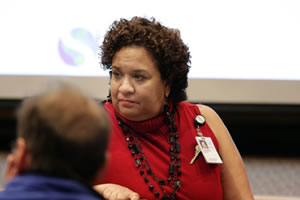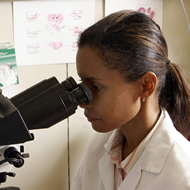
Environmental Factor, November 2008, National Institute of Environmental Health Sciences
Hispanic Heritage Talk Focuses on U. S.-Mexico Binational Programs
By Melissa Fabiano
November 2008





On September 25 in Rodbell Auditorium, NIEHS Superfund Basic Research Program (SBRP) (http://www.niehs.nih.gov/research/supported/sbrp/about/index.cfm) grantees Denise Moreno Ramírez and Monica Ramírez participated in the NIEHS Hispanic Heritage Month celebration with their joint presentation, “Toward an Informed Mexican and Mexican-American Citizenry.” The talk was sponsored by the NIEHS Diversity Council Hispanic Heritage Committee and hosted by NIEHS Health Disparities Postdoctoral Fellow Rose Marie Ramos, Ph.D.
The speakers are affiliated with The University of Arizona (UA) SBRP (http://superfund.pharmacy.arizona.edu/) ![]() Community Outreach (CO) and Research Translation (RT) Cores, where Moreno Ramírez serves as CO Core and U.S.-Mexico Binational Center for Environmental Sciences and Toxicology(http://binational.pharmacy.arizona.edu/index.php)
Community Outreach (CO) and Research Translation (RT) Cores, where Moreno Ramírez serves as CO Core and U.S.-Mexico Binational Center for Environmental Sciences and Toxicology(http://binational.pharmacy.arizona.edu/index.php) ![]() coordinator and Ramírez is RT Core coordinator. The two programs highlighted in their presentation were CampCIENCIAS (http://www.niehs.nih.gov/news/newsletter/2008/august/sbrp.cfm), a prototype science education program with a focus on high school students who live on and near the U.S.-Mexico border, and an ongoing series of training sessions for community health advocates, known in their communities as promotoras (http://www.niehs.nih.gov/news/newsletter/2008/july/tucson.cfm).
coordinator and Ramírez is RT Core coordinator. The two programs highlighted in their presentation were CampCIENCIAS (http://www.niehs.nih.gov/news/newsletter/2008/august/sbrp.cfm), a prototype science education program with a focus on high school students who live on and near the U.S.-Mexico border, and an ongoing series of training sessions for community health advocates, known in their communities as promotoras (http://www.niehs.nih.gov/news/newsletter/2008/july/tucson.cfm).
Since its inception, the mission of the UA SBRP and U.S.-Mexico Binational Center, Ramírez explained, has been “to reduce the burden of human illness and dysfunction from environmental exposures.” Moreno Ramírez and Ramírez foster the growth and development of UA’s unique international outreach program that targets Mexican and Mexican-American communities in the southwestern U.S., U.S.-Mexico border region and Mexico itself.
In addition to CampCIENCIAS and promotoras training, the program’s outreach efforts have included collaboration with:
- Academic institutions, such as the Universidad Nacional Autónoma de México (UNAM)
- Government agencies, including the U.S. EPA Arizona/Sonora Border 2012 Waste and Enforcement Task Force
- Local industries for remediation of mine tailing(http://www.niehs.nih.gov/news/newsletter/2008/march/mexico.cfm), hazardous waste landfills and other environmentally impacting activities
- Community citizens through specialized workshops and the distribution of educational literature in English and Spanish on environmental health topics
These programs are just a few of the Cores’ outstanding efforts to bridge the gap between academia and citizens. As Moreno Ramírez explained, the fundamental belief she and her colleagues bring to their work is that “citizens are well equipped to change social, political and environmental conditions since they are more knowledgeable about their own community and, therefore, ought to be considered ‘local experts’ in their own right.”
To help put this theory of “citizens as experts” into practice, the CO/RT Cores strive to educate Mexican and Mexican-American residents through a “circle” of action. The circle is divided into four quarters — training, community needs, science translation and engagement — that the speakers said must be addressed in unison as the basis for a successful CO/RT program.
Case studies presented by the UA CO/RT Cores demonstrated that the circle concept can yield important benefits in terms of planning future training, developing local and non-governmental organizations in Mexico, creating and utilizing bilingual materials, and engaging appropriate governmental and grass roots organizations.
Moreno Ramírez and Ramírez expressed their hope that the CO/RT Cores will continue to successfully impact the U.S.-Mexico border environment and people. They want the Cores to encourage academics and government agencies to involve citizens and institutions to a greater extent when tackling local environmental issues. Together, Moreno Ramírez and Ramírez envision the CO/RT Cores playing an even more pivotal role in UA SBRP in the future.
Following the talk, the speakers joined members of the audience and others at NIEHS for refreshments and entertainment (see related story (/news/newsletter/2008/november/hispanic-h-month.cfm)).
(Melissa Fabiano is a communications specialist for MDB, Inc., a contractor for the SBRP and the Worker Education and Training Program. She is a regular contributor to the Environmental Factor.)
"Intramural Papers......" - previous story ![]()
![]() next story - "Employee Services Holds......"
next story - "Employee Services Holds......"
November 2008 Cover Page



